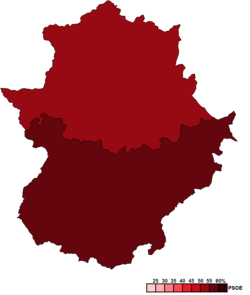| |||||||||||||||||||||||||||||||||||||||||||||||||||||||||||||||||||||||||||||||||||||||||
All 65 seats in the Assembly of Extremadura 33 seats needed for a majority | |||||||||||||||||||||||||||||||||||||||||||||||||||||||||||||||||||||||||||||||||||||||||
|---|---|---|---|---|---|---|---|---|---|---|---|---|---|---|---|---|---|---|---|---|---|---|---|---|---|---|---|---|---|---|---|---|---|---|---|---|---|---|---|---|---|---|---|---|---|---|---|---|---|---|---|---|---|---|---|---|---|---|---|---|---|---|---|---|---|---|---|---|---|---|---|---|---|---|---|---|---|---|---|---|---|---|---|---|---|---|---|---|---|
| Opinion polls | |||||||||||||||||||||||||||||||||||||||||||||||||||||||||||||||||||||||||||||||||||||||||
| Registered | 824,866 | ||||||||||||||||||||||||||||||||||||||||||||||||||||||||||||||||||||||||||||||||||||||||
| Turnout | 583,172 (70.8%) | ||||||||||||||||||||||||||||||||||||||||||||||||||||||||||||||||||||||||||||||||||||||||
| |||||||||||||||||||||||||||||||||||||||||||||||||||||||||||||||||||||||||||||||||||||||||
 Constituency results map for the Assembly of Extremadura | |||||||||||||||||||||||||||||||||||||||||||||||||||||||||||||||||||||||||||||||||||||||||
| |||||||||||||||||||||||||||||||||||||||||||||||||||||||||||||||||||||||||||||||||||||||||
The 1991 Extremaduran regional election was held on Sunday, 26 May 1991, to elect the 3rd Assembly of the autonomous community of Extremadura. All 65 seats in the Assembly were up for election. It was held concurrently with regional elections in twelve other autonomous communities and local elections all throughout Spain.
Contents
- Overview
- Electoral system
- Election date
- Opinion polls
- Results
- Overall
- Distribution by constituency
- Aftermath
- Notes
- References
The Spanish Socialist Workers' Party (PSOE) won the largest absolute majority a party would achieve in a regional election in the history of Extremadura, with 39 out of 65 seats (60% of the seats) and slightly above 54% of the vote share. The newly founded People's Party, successor of the late People's Alliance, recovered from AP 1987 results and gained two seats. The Democratic and Social Centre lost seats and votes, falling behind United Left (IU), which gained support and finished in third place for the first time in a regional election. Meanwhile, the regionalist United Extremadura (EU) lost more than half its support and was left out from the Assembly, losing all its seats.
As a result of the election, Juan Carlos Rodríguez Ibarra was elected for a third consecutive term in office.


